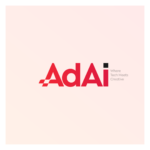Guest Contributor, Farrokh Mansouri
Marketers can no longer afford to view adopting new technologies as merely a benefit. It has become a necessity, especially in light of the rapid advancements in Artificial Intelligence. These rapid advancements are pressuring marketers to develop a knowledgeable and responsible AI strategy. Falling behind is not an option. With the advertising industry quick to embrace this wave of innovation, professionals must have a deep understanding of the opportunities and challenges presented by AI.
Businesses must balance experimentation and informed risk management to stay ahead of the curve. The past few years of unprecedented AI development and applications have opened up unimaginable opportunities.
There are numerous applications of AI in advertising, especially in out-of-home (OOH) advertising, that can help companies achieve their advertising objectives.
- Enhancing targeting and contextualizationOne powerful potential of AI lies in its ability to analyze enormous amounts of data rapidly and provide unprecedented insights. For marketers, this translates to improved data analytics for audience targeting and understanding the appropriate combinations of media, platforms, and locations. Spatial AI is one of the significant advancements that can help you identify the most suitable location for accomplishing your advertising objectives.
- Post-campaign analytics and engagement metricsAI technology is poised to transform the advertising industry significantly. By leveraging AI, it will be easier to access big data analytics, allowing businesses to extract valuable insights with minimal effort. This democratization of analytics resources is expected to revolutionize the industry. Measuring the return on investment of your campaign using conventional analytics tools can take time, as some key performance indicators (KPIs) are not easily quantifiable. The impact of advertising may have time lags and may not be apparent after simply analyzing sales spikes. Measuring KPIs such as brand equity can also be challenging. Analyzing campaigns will become more accessible thanks to AI-powered systems, as these tools will develop analytics for complex data sources, including sensors, population movement data, and point-of-sale data, resulting in more comprehensive insights. AI-powered analytics tools offer a versatile solution that can handle the intricacies of individual campaigns and are not just cookie-cutter approaches but adaptable resources capable of handling any conceivable data analysis.
- Data privacy and regulatory complianceAI provides solutions for privacy and regulatory challenges associated with handling sensitive data. For instance, analytics derived from camera footage can be immensely valuable in measuring the effectiveness of ads. However, there are many privacy hurdles to overcome to use such data. Fortunately, AI developments make it possible to perform on-device analysis of the camera data, thereby ensuring a privacy-compliant solution to these challenges. AI will create opportunities to analyze data that is considered otherwise sensitive, thereby enabling new data utilities and applications. You can capture real-time impressions using cameras or sensors, analyze viewers’ emotional reactions and demographic data, and even estimate the duration of engagement.
- Automation and efficiencyAutomated content managAement, ad placements, and even billing can be streamlined using AI. This reduces manual intervention errors and enhances efficiency, allowing OOH businesses to focus on strategy and creativity. This will result in increased productivity of many advertising functions. For example, we will see increased personalization, interactivity and immersive experiences. Imagine billboards or displays that can interact with a passerby, offer augmented reality experiences, or even respond to voice commands. AI can power such experiences, setting the stage for the next era of interactive OOH advertising. Another great example is dynamic content optimizations (DCOs) tailored to the situation and audience. Many creatives must be prepared to allow for refined and high-fidelity DCOs, which already limit many possibilities due to the work needed for these sophisticated campaigns. However, generative AI might offer a solution that provides DCOs which can work in situations the design team didn’t prepare for.
While AI presents opportunities for the advertising industry, it’s crucial to acknowledge the potential risks that could be associated with AI use. When implementing AI, consider concerns about privacy, security, intellectual property infringement, and potential biases in AI systems. Fortunately, best practices are beginning to emerge across all sectors – including at the voluntary level (federal government’s new generative AI code, NIST, OECD, etc.) and through Canada’s proposed Artificial Intelligence and Data Act, which is still working its way through the parliamentary process. The way forward AI presents a transformative opportunity for industry professionals. By understanding, embracing, and using it responsibly, marketers can create impactful, engaging, and compliant campaigns that resonate in this digital age. Ignoring AI is not an option, but neither is a blind, uneducated adoption.
The key to success lies in knowledge, understanding, and a careful approach. Let us prioritize education and a deep understanding of AI, so that we may fully embrace its potential.
The AdAI Toronto Conference launches this Friday November 3rd, 2023. As the world’s first AI conference for the advertising industry and aims to educate and inspire in the tech and creative spaces alike. Marketers and media specialists will benefit from a comprehensive program of today’s cutting edge topics by panelists who will shed light on the opportunities, challenges, and overall extensive future of AI.
Individual ticketss cost CAD 395 and can be found here. COMMB members should contact the association for an exclusive discount code.
The conference is hosted by COMMB’s Director of Marketing Lara Menzies and chaired by COMMB’s Head of Data Science Farrokh Mansouri.
 At COMMB, Farrokh works on novel approaches to incorporate new data, analytics, and technologies for OOH measurements and marketing. He comes from a highly multidisciplinary background with experience applying data science, machine learning, and artificial intelligence in the fields of transit, medicine, climate science, and finance. Farrokh has previously built and managed technical teams in various startups and large companies and holds a BASc, MHSc and PhD in Engineering from the University of Toronto. He has authored over 20 research papers published in prestigious scientific journals.
At COMMB, Farrokh works on novel approaches to incorporate new data, analytics, and technologies for OOH measurements and marketing. He comes from a highly multidisciplinary background with experience applying data science, machine learning, and artificial intelligence in the fields of transit, medicine, climate science, and finance. Farrokh has previously built and managed technical teams in various startups and large companies and holds a BASc, MHSc and PhD in Engineering from the University of Toronto. He has authored over 20 research papers published in prestigious scientific journals.


Follow DailyDOOH